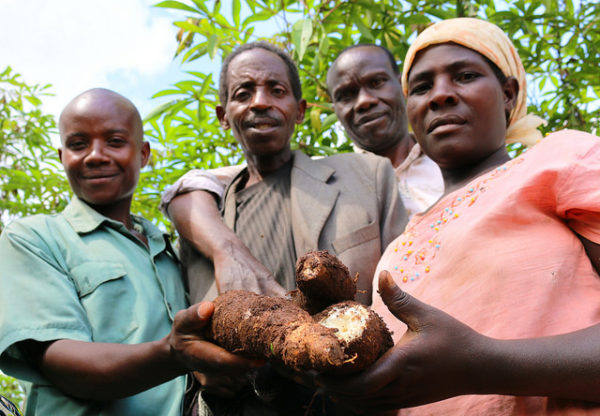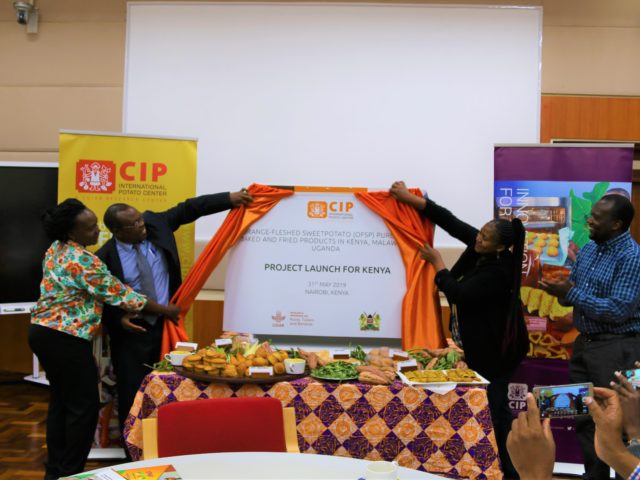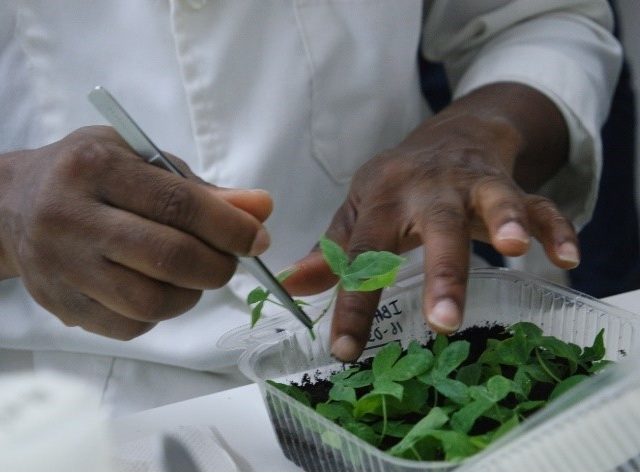Cassava is a key source of food and income in many developing countries in Africa. In sub-Saharan Africa, it is a major staple providing over 20% of calorific requirements and constituting nearly two-thirds of per capita food production.
However, one of the major challenges facing cassava is the rapid postharvest physiological deterioration of fresh roots which usually make them unpalatable within two to three days of harvest. Consequently, cassava roots need to be consumed or processed soon after harvesting.

Smallholder farmers in Uganda pose with their cassava harvest. Innovations that prolong the shelf-life of cassava are in high demand by farmers and traders. Photo S. Quinn/CIP
This short shelf-life severely restricts the marketing options for the crop as it increases the likelihood of losses, marketing costs, and limits access to distant urban markets. It also creates high postharvest losses, often forces farmers and retailers to sell produce at discounted prices and limits food security in the many nations dependent on cassava as a staple food.
The application of technologies that extend the cassava shelf-life, such as waxing and relative humidity storage, can increase marketing opportunities and incomes for smallholders as well as contribute to the reduction of postharvest losses that affect directly mainly retailers and indirectly all value chain actors.
As part of the Expanding Utilization of Roots, Tubers and Bananas and Reducing Their Postharvest Losses project (RTB-ENDURE), two practical manuals have been developed to build the capacities of actors in producing, handling, processing and marketing fresh cassava roots whose shelf-life is extended through these technologies.
The first manual provides information on how setting up a pack house for waxing and relative humidity storage. The second manual guides users on the best handling methods for fresh cassava roots right from field preparation to marketing.

Sharon Acheng of Makarere University holds a waxed (back) and a non-waxed (front) cassava root. Sharon is one of three students who conducted post-graduate research on cassava in coordination with National Agricultural Research Organization (NARO) of Uganda and RTB. Photo S.Quinn/CIP
Both manuals are valuable resources for entrepreneurs and organization willing to establish and run such a processing plant as well as farmers interested in supplying roots to the pack house.
The CGIAR Research Program on Roots, Tubers and Bananas (RTB) will continue research to expand the utilization of RTB crops and add value through postharvest innovation, as part of the program’s Flagship Project 4 (FP4).
FP4 will address the perishability of root, tuber and banana crops through improved storage, transportability and diversified use, while promoting gender-equitable development and youth employment along the value chain. The flagship will also develop improved methods for postharvest process modeling that integrate technical, economic and environmental aspects and enhance the sustainability and profitability of the postharvest sector.
Read more about the RTB-ENDURE project’s work on cassava in our photo story ‘Creating change with cassava: Improving livelihoods of cassava farmers and traders in Uganda’.



